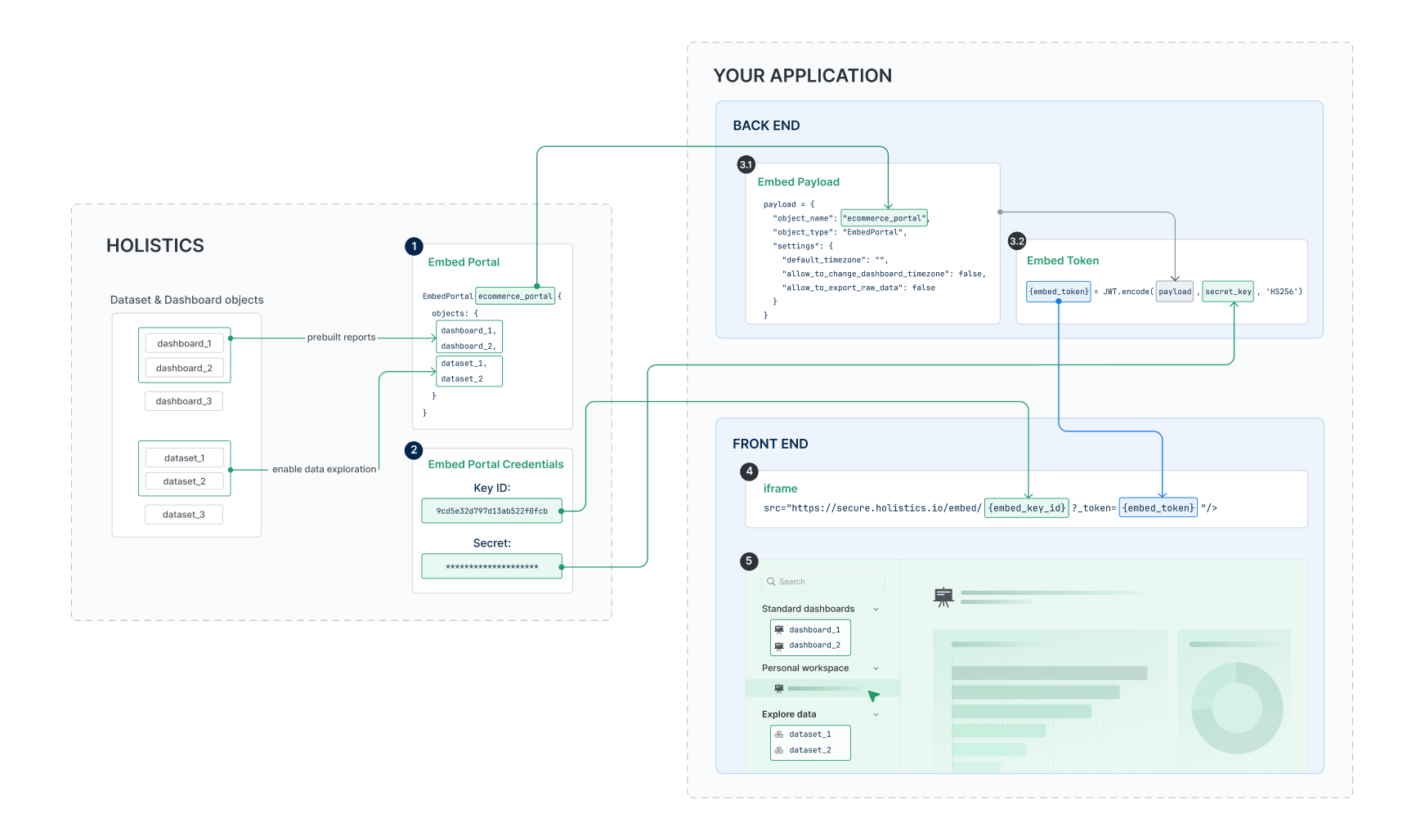Embed Portal - Getting started
This is a Beta feature. The documentation and feature may change rapidly. You can request Beta access and try it out.
- You need to enable git flow
- If you connect Holistics to your own repository, you need to make sure there is no protected branch restrictions
Overview
Creating an Embed Portal involves four main steps:

Setup in Holistics
1. Define your portal in a .embed.aml file
2. Generate embed credentials
Integrate into your application
3. Backend Token Generation
4. Frontend Iframe Presentation
Setup in Holistics
Step 1: Define your portal
Create your portal file
- Create a new file in your Development tab with the naming convention:
*.embed.aml - Add dashboards and datasets that you want to embed into the Embed Portal
EmbedPortal sales_portal { // object with a unique name
objects: [ // array containing the dashboard and dataset names.
sales_overview, // dashboard
revenue_trends, // dashboard
sales_data, // dataset
// Since objects are unique across your Holistics instance, you can simply list the object names
// Holistics automatically detects whether each object is a dashboard or dataset.
],
}
Choosing What to Embed
-
Dashboards: Deliver instant, actionable insights through pre-built reports—no configuration required.
-
Datasets: Enable powerful data exploration—let users slice and dice data to create custom visualizations on demand.
Preview in development
You can preview your embed portal before publishing to production by navigating to the Preview tab. It helps you validate changes, catch errors, and test configurations in development.
Publish to production
Once you're satisfied with the preview, publish your portal to make it available for embedding.
For more information, please refer to publishing to production
Step 2: Generate embed credentials
- Navigate to Tools → Embedded Analytics
- Find your published portal in the list
- Click Enable to activate embed credentials
- Note your Key ID and Secret - you'll need these for integration
You only need to generate embed credentials once; the same credentials can be used for all your embedded portals.
Integrate into your application
Step 3: Backend Token Generation
To embed your portal into your application, you need to generate secure tokens on your backend.
In your application backend, generate embed tokens using this structure:
// Basic embed payload
const embed_payload = {
object_name: 'customer_analytics',
object_type: 'EmbedPortal',
settings: {
default_timezone: "UTC",
allow_raw_data_export: false,
}
};
// Generate token (implementation depends on your backend)
const token = jwt.sign(embed_payload, embed_secret, { algorithm: 'HS256' });
Step 4: Frontend Integration
Basic iframe Implementation
<!-- Generate this URL in your backend -->
<iframe src="https://holistics.io/embed/{embed_key_id}?token={generated_token}" width="100%" height="600" frameborder="0"></iframe>
Optional: Call API to generate Embedded URL (or embedded token)
// Frontend JavaScript example
async function loadPortal(userId, orgId) {
// Call your backend to generate token
const response = await fetch('/api/embed-token', {
method: 'POST',
headers: { 'Content-Type': 'application/json' },
body: JSON.stringify({
portal: 'customer_analytics',
})
});
const { embedUrl } = await response.json();
// Update iframe source
document.getElementById('portal-iframe').src = embedUrl;
}
Embed portal payload's parameters
| Parameter | Type | Description | Required |
|---|---|---|---|
object_name | string | Name of your EmbedPortal | ✅ |
object_type | string | Must be 'EmbedPortal' | ✅ |
embed_user_id | string | Unique identifier for the user | For SSBI features |
embed_org_id | string | Unique identifier for user's organization | For org workspaces |
user_attributes | object | Values for row-level permissions | If using row-level permission |
settings | object | Portal configuration settings | Optional |
permissions.enable_personal_workspace | boolean | Enable personal workspace for user | Optional |
permissions.org_workspace_role | string | User's role in organization workspace: 'no_access', 'viewer', 'editor' | Optional |